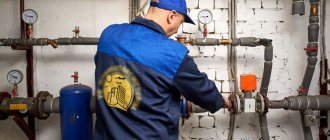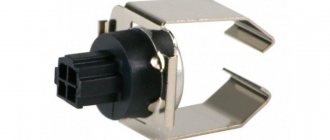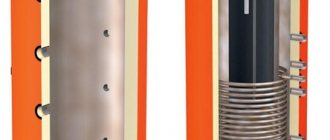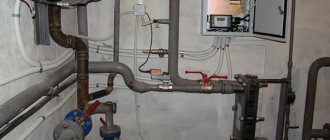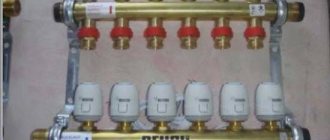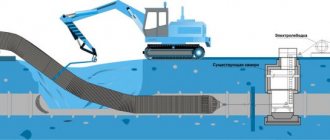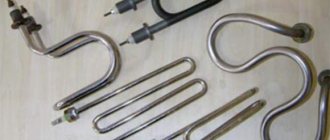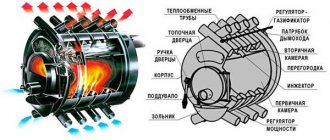These days, the lion's share of family income goes to paying heating bills. Every year this service becomes more and more expensive, but not everyone’s income increases, so many families are forced to tighten their belts to keep their homes warm in winter. It goes without saying that many would like to reduce these expenses as much as possible and begin to keep these expenses under personal control. Fortunately, there is a way out of this situation. To do this, you need to purchase and install heat meters for heating.
This device is designed to keep track of energy consumption for heating a home. As practice shows, if you install a heat meter correctly, you can save from 25 to 50% of money on heating your living space. Such a difference in amounts is dictated by the peculiarities of the building in which the installation of this equipment is planned. In this article we will talk about the operating principle of this equipment, its classification and how to properly install heat meters.
Installed heat meter
Return to content
Ultrasonic heating heat meter
This type of meter is often installed as a universal device in apartment buildings. The principle of its operation is an ultrasonic signal, thanks to which the device essentially takes measurements (using a sensor). This signal passed through the water. The complete set of this device consists of an emitter and a device that produces a signal. These components are installed opposite each other.
Rice. 3 Ultrasound machine
It is better to install an ultrasonic device in houses with new piping, as it is very sensitive to contamination.
Ultrasonic heat meters come in the following types:
Each of these types only gives accurate readings if the water is clean and free of impurities. Any dirt or even air bubbles can affect the readings.
The advantages of this meter include the information content, which is achieved through the liquid crystal display, and also the fact that when installing this model, the hydraulic pressure does not increase.
But there is also a drawback in the operation of the ultrasonic device - if the power supply is unstable, connect it via UPS.
Let's sum it up
Briefly, the process of installing a heat meter can be described in 5 stages:
Registration of permitting documentation for the installation of this measuring equipment.
- Selecting and purchasing a heat meter.
- Order or create an installation diagram yourself.
- Direct installation.
- Sealing the installed product and receiving an acceptance certificate.
After that, you will pay your heating bills by seeing these readings. With this device you can save a significant amount, but the benefits will not be noticeable immediately.
Return to content
Options for installing metering devices
The advantages of installing metering devices are obvious. The homeowner will pay only for the heat received, without having to fork out to compensate for losses during its transportation. For maximum savings, you should remove all sources of possible heat loss in the house: install sealed lamps, insulate the room, etc. There are two options for installing the counter.
Method #1 - communal meter
Residents of multi-storey buildings can solve the problem of heat metering by installing a regular home meter. This, by the way, is the cheapest option. After all, the price of a heat meter, which is not cheap, and its installation will “scatter” among the owners of several apartments. The resulting amount will be quite acceptable. The readings of such a device are taken once a month. The fee is set for each apartment depending on its area. In addition, if the service provider does not perform its part of the contract in good faith and does not provide the agreed temperature in the house, it will be obliged to return the money paid to the tenants.
You should start by holding a general meeting of apartment owners. It is necessary to discuss all the nuances of the next installation and decide who will take meter readings and issue payment receipts. The decision of the meeting must be recorded in the minutes, after which you can contact the management company with a written application to connect the device.
The cheapest way to measure the heat in a device is a common house meter. However, for a number of reasons, an economic effect cannot be expected from this.
Method #2 - individual measuring instruments
The main advantage of a conventional household appliance is its low cost. However, the economic effect of its use may be much less than expected. And there are many reasons for this. For example, the entrances or apartments of neighbors are not insulated enough, as a result of which heat losses are prohibitively high. Therefore, many people choose individual heat meters, which are installed directly in the apartment. This is a more expensive but very effective option.
Distributors are installed on each radiator in the apartment. The temperature of the batteries is recorded for a month, noting the slightest differences. Based on this information, the thermal charge is calculated
Before planning the installation of a single metering device, you need to become familiar with some technical limitations. The heat meter is mounted on the riser leading to the apartment. In older apartment buildings, vertical distribution of heating pipes was carried out more often. This means that an apartment may have several risers, for each of which it is necessary to install one device, which is extremely unprofitable. A solution to the problem could be to install special meters on heating radiators, but in our country such equipment is not used, although this is common practice in European countries.
Manufacturers of metering devices suggest installing so-called distributors in houses with vertical wiring, which measure coolant flow based on the temperature difference on the surface of the battery and in the air in the room. Another solution to the problem is a common house meter. In houses with horizontal wiring, installing any heat meters in an apartment is not at all difficult. Compact models of devices are installed on the pipe supplying coolant to the room or, in some cases, on the return pipe.
Types of heating meters for individual rooms and the whole house
The main motivator for saving any energy resources, as well as reducing financial costs, is the installation of an individual type meter. Under such conditions, each resident of an apartment building can control the consumption of heat resources in his apartment or even in a separate room. In the case of common household appliances or calculations according to general standards, few people set themselves the task of saving - if it’s hot, then it’s easier to open the window, and if it’s cold, complain to the housing and communal services. In addition, some residents drain hot water from radiators to use it for washing floors or cars, but they have to pay for this collectively.
Mechanical models
Mechanical heat meter SANEXT in MONO modification
A mechanical heat consumption calculator is the simplest model of such devices, where the readings are based on the movement of the coolant by activating a turbine, screw or impeller, and is installed either on the water supply or on the “return”. The most important advantage of such a device is its low cost compared to other options; it varies between 6,000 and 10,000 rubles. The negative characteristics of such models include the following indicators:
- if the water has increased hardness, is contaminated with rust or anything else, then the rotating parts very quickly fail as if they are worn out;
- in the event of a sharp pressure drop in the common heating circuit, its readings will be incorrect (in one direction or the other);
- The operational resource is limited to a period of 2 to 4 years.
Electromagnetic models
Electromagnetic type computing device
Today, electromagnetic-type devices are gaining priority over mechanical models, both in the construction market and in consumer demands. Their activity is based on the principle of electromagnetic induction - the movement of the coolant generates an electric current.
Positive traits:
- accuracy in issuing indicators;
- when generating electric current, it does not come into contact with water, which makes the device safe;
- relatively affordable cost (about 17,000 rubles).
Negative qualities:
- technical difficulties may arise in connecting if you do not know how to do this;
- if the quality of the coolant is reduced (rust or oil in the water), there may be interruptions in the readings.
Vortex models
Vortex type computing device
Vortex meters for heating calculate heat energy based on the number of turbulent eddies that occur when water passes through obstacles. The cost of such computers is quite affordable - on average they cost 15,000 rubles.
Positive traits:
- accuracy in issuing indicators;
- Possibility of installation on both horizontal and vertical pipes;
- Neutral to sludge on walls and water of high hardness.
Negative qualities:
- in the event of the formation of air locks and even the presence of air bubbles, as well as rust, the accuracy of the readings may deteriorate;
- indicators can react to sudden changes in coolant temperature, for example, welding work on a metal circuit;
- Installation of the device is possible only on a straight section of pipe.
Ultrasonic models
Ultrasonic measuring instrument Sensostar 2U
Ultrasonic metering devices are considered the most reliable and high-quality; their service life is practically unlimited. The coolant is taken into account using the time period required to pass from the source to the receiver through the water flow. The signal is delayed by the movement of fluid in the circuit, and the time of this delay determines the reading.
Negative qualities:
- if the coolant is contaminated with something or there are air bubbles, then the signal travel time changes, distorting the meter readings;
- such devices can be expensive - their cost varies from 15,000 to 48,000 rubles.
Recommendation for use for all meters. To maximize the service life of any type of metering device, a magnetic mesh filter should be installed in front of it for water purification. The filter is mounted on the supply side.
Video: Thanks to individual heat meters, people in Penza pay 2 times less
Recommendations for choosing a device and its installation
To correctly take into account the small flow rate of coolant used to heat an apartment, 2 types of household heat meters are used:
- mechanical (otherwise known as a tachometer);
- ultrasonic.
Note. The technical parameters of commercial measuring instruments are determined by designers based on calculations.
This is what tachometers look like
To understand the difference between them and make the right choice, you need to understand a little how a heat meter works. It consists of three main elements that perform their functions:
- A flow meter whose task is to determine the amount of water flowing through a section of pipe per unit of time. Breaks in the supply pipeline.
- Forward and return flow temperature sensors (resistance thermocouples).
- Electronic calculator block. Receiving signals from sensors and a flow meter, the device calculates the consumed heat using the formula included in the program. The result is shown on the display and can be transmitted to the provider via GSM or Internet connection.
Ultrasonic heat meters are designed for installation in apartments
Important point. When issuing specifications, heat supply organizations strongly recommend installing ultrasonic heat meters in the apartment. The reason is not only reliability and durability. Unscrupulous residents only think about how to deceive any meters, including heat meters (for example, stop using magnets). The operating principle of the ultrasound device does not allow illegal influence on the readings.
Surface heat meter from the famous European brand Danfoss
It is impossible not to mention another type of heat consumption analyzers - pendant devices installed directly on the battery (so-called proportional converters). They determine energy consumption by the temperature of the heat dissipation surface and air in the room, only you need to first enter the technical parameters of the radiator into the device’s memory.
Dispensers are widely used in Western Europe, but are not yet in demand in the post-Soviet space due to inconsistency in legislation. However, large cities have already accumulated some experience in the successful use of such heat meters, which is described in the video:
As mentioned above, the installation of the heat meter is carried out by the personnel of an authorized company. You can only check their operation knowing that the flow meter is installed on the supply pipe and that the sensors intervene in the supply and return. In addition, in new models there is only one sensor - for the return line, and the flow temperature meter is integrated into the flow meter housing.
As a rule, in modern heat meters there is no need to observe measuring sections (straight pipes of a certain length before and after the device).
Product selection criteria
When choosing a thermal product, you need to focus not only on the cost and advertising description, but also on the operation of heat meters. However, they must meet the following characteristics:
- Water measurement range;
- Hydraulic losses after installation of the device. The diameter of the channel behind the meter should not be less than that before the device;
- Saving money. The cost of the product and all components required for installation;
- The prevalence of this device in the region of residence, reviews about it;
- Service of the selected counter.
Types of heat metering devices
Important. Without the appropriate certificate for the device, the management company will not take the product into operation, so when purchasing, be sure to request this document from the distributor
In addition to the above parameters, such indicators of devices as the coolant inlet circuit and the working fluid itself are important for specialists, and they also need to know the limit values of the existing parameters for this coolant.
An important factor when choosing a device to be installed in an apartment is the model and cost of the selected product:
| Model | Type | Flow (nominal) | Market average cost, rub. |
| Engelmann Sensostar 2 | Electromechanical | From 1.5 to 2.5 m3/hour | 13 185 |
| Engelmann Sensostar 2U | Ultrasonic | From 1.5 to 2.5 m3/hour | 15 300 |
| Landis&Gir T-230 | Ultrasonic | From 1.5 to 2.5 m3/hour | 15 300 |
| Landis&Gir T-550 | Ultrasonic | From 0.6 to 2.5 m3/hour | 17 680 |
| Landis&Gir T-2WR6 | Ultrasonic | From 0.6 to 2.5 m3/hour | 17 600 |
| Apator ELF | Electromechanical | From 0.6 to 2.5 m3/hour | 12 300 |
Comparison table of popular models and prices
approximate cost
The most affordable radiator meters are mechanical devices; they can be purchased for about 3,500 rubles.
Ultrasound machines are more expensive, prices start at 4,000 rubles.
On average, popular models cost around 5-6 thousand rubles.
When choosing a radiator meter, you need to know the diameter of the pipe on which the device will be installed. The thicker the tube, the higher the cost of a suitable heat meter.
Typically the kit includes a counter, a flow meter and a pair of sensors for the supply and return pipelines. Additionally, you will need to purchase additional parts:
- mechanical cleaning filter for the flow meter - 300 rubles;
- T-shirt for connecting a temperature sensor - 800 rubles for 2 pieces;
- shut-off valve to stop the flow of water - 500 rubles for 2 pieces;
- water flow control valve - 1000 rubles for 2 pcs.
Almost every city has a company that installs heat meters. Its representatives will help prepare the project, carry out installation and commissioning of the device. Depending on the complexity and volume of work, the price for such services will vary from 2,000 to 7,000 rubles.
In total, if you calculate the approximate cost of installing a meter, you get 4,500 per meter, 2,500 for additional parts and 4,000 rubles for design and installation. It turns out 11,000 rubles.
If the house uses a vertical heating system, then a heat meter must be installed on each riser. In other words, you will have to install a heat energy meter in each room, which will inevitably lead to an increase in the payback period.
For example, for a three-room apartment you will have to install a meter in all three rooms and in the kitchen, it turns out that instead of one device you will have to pay for four, and as a result, the return for such a system will be four times greater.
It is also worth considering that for corner apartments, where two walls are external to the room, radiators are installed on each wall, and accordingly in such a room there may be not one, but two risers, and you will need to install a meter for each heating coil.
Due to all these disadvantages caused by the vertical arrangement of pipes, heat distributors were invented. The cost of the device is 1000 rubles, installation is 500 - 1000 rubles per person. Therefore, for a three-room room you will need 4 such distributors, that’s 4000 rubles, 3000 rubles for their installation and 500 rubles for shut-off valves or one valve for each battery, that’s another 2000 rubles. Thus, it turns out 10,000 rubles, which is comparable to installing a heat meter in a system with horizontal heat distribution.
Comments
To be honest, I didn’t even think about the fact that counters could have such a strong influence. Our husband installed any one from the store, and it works well, we are happy. sometimes it feels like the more you think about something, the worse you do for yourself. You put it as it is and move forward. If you are destined to pay an amount for services, then there is no escape. No matter what you install.
Answer
January 04, 2016
When I installed a mechanical meter with an impeller in my country house, I didn’t know that it would only last a month, I found out about this when I was given a bill that was not commensurate with the meter readings, then I found out that the problem was in the hard water that was flowing through these pipes, but this meter couldn’t cope with it. I had to replace it with electromagnetic ones.
Answer
January 27, 2016
The problem is with these meters, collect the documentation and make control measurements. It’s easy even for a schoolchild to install such a thing, but everything else… let the designer do the work, there’s all the information for him from A to Z, and we’ll work on it.
Answer
March 02, 2016
My sister has a new building. And meters are installed in each apartment. You choose how much to turn on the heating. My sister sets the heating to minimum. As a result, the counter hardly spins. The heating fee is negligible. They even sent the device for unscheduled verification twice. didn't believe it.
Answer
March 14, 2016
Alina, installing a meter does not imply installing a regulator. The first is mandatory and has no effect on heating. he just counts.
Answer
March 16, 2016
We installed an electromagnetic meter in the fall and don’t regret it at all, although there was a lot of fuss before it. But now I pay as much for heating as I really should. The only thing you need to do is find time and be patient if you decide to install a meter.
Answer
March 30, 2016
The whole house switched to meters and I had to install them because I argued with the neighbors - they pay according to the meters, but they don’t want to pay for general house expenses and they talk about me. I designed it, installed it, and of course it stretched. Now I pay less for heating, but we can’t figure out how to divide general house costs. You think it should be divided depending on the area of the apartment, but many do not agree with this, because someone lives alone or does not live in an apartment at all, but lives in the country .
Answer
Is it profitable to install a meter in an apartment?
It is beneficial to install a heating meter in your apartment. The owner of the house spends money only on the heat provided by radiators, without paying for losses during transportation. To save as much as possible, it is necessary to eliminate as much as possible all possible sources of heat loss: insulate the room, install sealed lamps, etc.
It is guaranteed that you will be able to save on payment and get your money back if:
- obtain permission for installation and technical specifications from the heat supply organization;
- inform the responsible person elected by the general meeting;
- it will be possible to install 1 meter for the entire apartment;
- coordinate design documentation with the heat supplier;
- deliver the installed device to him for operation, after which the device must be sealed.
After all, it is quite difficult to comply with all the listed points for installing a heat meter in an apartment and paying for heat supply according to its readings. The most successful option may be a new building, in which each apartment has a separate heat supply. In addition, various obstacles may arise in the form of various legislative acts. For example, in the Russian Federation there is a decree according to which the readings of individual heat meters are subject to recording if the following conditions are met:
- Heat meters must be in all apartments;
- a common heat meter must be installed at the entrance to the central heating of the house.
Almost all Soviet-era skyscrapers are equipped with a single-pipe heating system with vertical risers. Imagine the number of lights that would need to be installed at each riser connection. It is also unlikely that you will be given permission and the refusal will be justified. The riser pipes also emit heat, which will not be taken into account by the individual meter.
If heating radiators are installed in the house on stairs and other technical rooms, despite the installation of an individual heat meter, you will have to pay your share for heating them. Here, step by step, you must coordinate all your actions with the management of the condominiums. The installation work itself is a fairly simple stage; most of the time should be spent on developing various approvals and permits.
You can install the heat meter yourself, but then difficulties may arise when putting it into operation by the management company. Then you can contact a contractor who, for a fee, will help solve the problem with the documents.
Basic approvals required when connecting meters
From filling out the application to accepting the heating meter in the apartment, you will have to go through stages defined by law, each of which will require a significant expenditure of effort, nerves, time, and material investments.
Is it possible to install a heating meter in an apartment - seven steps that must be completed in order for everything to be legal.
Before starting the process, finally decide whether it is worth doing. Find out from the management company about the actual number of meters already installed in an apartment building, whether such precedents exist.
Drawing up an application, project, obtaining technical specifications
The first stage is a visit to the management company, housing office or homeowners association. Here the following series of questions need to be addressed:
- Write an application for the creation of a commission to inspect the apartment in order to determine the technical feasibility of installing heating meters in the apartment, their location. Draw up an inspection report.
- If the commission makes a positive decision, write an application for permission to carry out this type of work related to changing the heat supply scheme and obtaining technical conditions agreed upon with the energy supply organization. The technical specifications form has a single form; you can see which heat meter is better.
- After obtaining permission and specifications agreed upon by all authorities, you can buy heat meters for batteries in an apartment or for other premises. Technical specifications are an important document; they are used to purchase meters, install them, and make a heat supply project.
- According to the technical specifications, order a project from a specialized design organization, which will indicate the installation location of the meters. In the case when the management organization gives the go-ahead to alter the heat supply scheme, bringing it to one riser, all the necessary changes are indicated in the project. The project is being approved by the management company and resource supply organization.
Purchasing a meter involves material costs.
Purchase of a meter, installation, commissioning
The device can be purchased only in specialized stores. Check the availability of a certificate for the products you sell. The device must comply with the parameters specified in the specifications. The passport must contain a stamp indicating verification at the manufacturer's plant indicating the date, and a warranty card.
The best option for installing heating meters in an apartment is to contact a specialized organization that has a certificate and permission to carry out this type of work. The organization must be included in the Unified State Register of Legal Entities (you can check it for free) and have an admission certificate for the relevant construction and design work (SRO). This is important when registering the meter with an energy-saving company.
- Draw up an agreement, costing, and estimate with the organization for the installation of the heat supply system and installation of devices. Decide on the warranty period, further support for the operation of heating meters in the apartment, carrying out verifications and eliminating emergency situations and meter malfunctions.
- After installation work and verification of the device, draw up a report with representatives of the management office and the energy saving organization.
- Write an application to the energy-saving company for registration and commissioning of the installed meters with a change in the layout of the heating system. From this moment on, you will be fully responsible for the correct operation of the devices and their technical condition. Control is carried out by the energy supply organization.
Entrust the selection of a central heating meter for the apartment to an organization that will be your executor. They will purchase devices that fully comply with the requirements of the specifications, taking into account the acceptable cost limits.
Apartment heat meters per battery: what are they?
There are 4 types of heat meters per apartment per battery:
Tachometer for battery
- Tachometer (more often they are called simply mechanical)
- Ultrasonic
- Electromagnetic
- Vortex
Tachometers are considered the cheapest. The average price of a heat meter per battery is 10 thousand rubles. The period does not exceed 4-5 years. The installation cost is at least 4 thousand rubles.
Ultrasonic battery heat meter
Ultrasound is more expensive, but not much. They provide greater accuracy of indicators and are not afraid of hard water.
Electromagnetic and vortex generators are expensive; they are purchased mainly by industrial enterprises and large organizations.
It should be taken into account that if you have a vertical heating network (that is, each battery has its own riser), then a heat meter will need to be installed on each drain. For a three-room apartment - 4 pcs. (Including kitchen radiator). Total - 56 thousand rubles. This kind of money will not pay for the counter's life.
Electromagnetic heat meter
Vertical wiring is used in old houses. Mostly Soviet built. Most modern residential buildings use horizontal wiring. This is when a supply pipe enters the apartment, on which all the batteries are “placed,” and then the used water comes out through the outlet pipe. In this case, the meter may pay.
Installing a heat meter on a battery is not an easy task. But even the design of this event is no longer simple. Necessary:
- Submit an application to the Housing Office and obtain permission to install a meter
- Draw up a project for installing a meter
- We coordinate the project with the housing office
- Install the counter
- Ask a housing representative to seal the meter
And this is every 5 years!
Installing a heat meter on a battery
Of course, if you order meter installation from a contractor, approvals and permits will be completed for you. And the other option is officially impossible - installation of heat meters for apartments on a battery can only be carried out by certified organizations that have the appropriate licenses. Nothing DIY!
Required documents
The installation process, registration of the meter and collection of documents varies between 6-8,000 rubles. If you want to prepare the documents yourself, be patient for a couple of months, visit the relevant authorities, and you will receive:
- Permission from the institution on whose balance sheet the house is located.
- Technical requirements from the balance holder of the building supplying heat.
- Calculated design of the heat consumption unit based on the selected device. Ready calculations are additionally coordinated with standard values.
- At this stage, installation should be done in accordance with each figure of the project.
- Conclude an agreement to the main contract with the heat supplier, providing for payment based on individual meter readings.
- Draw up a certificate of completion of installation of the unit with a representative of the organization supplying heat and register the device.
At first glance, the list does not imply any particular difficulties, if not for the obstacles in the form of additional documents for each item, and the wait for permitting papers up to 15 days.
two-pipe heating circuit
A horizontal heating scheme with a separate ceiling unit is what you should start from.
The location of the apartment is of great importance. The owners of corner apartments on the first and last floors need not worry. If comfort for you is indicated by an interval of degrees from 8 to 22 C, you will not feel a noticeable difference in budget savings.
The cost of individual meters ranges from 5,000 -8,000 rubles. Modern ultraviolet devices are more expensive, but are not always relevant for municipal conditions. The vertical contour is due to the connection of each section to a separate riser (two pipes): one comes out from above, the other goes down.
With a horizontal heating scheme, the pipes come out of the floor and return there.
In modern buildings, this type of wiring is usually used, although it costs 20% more than the previous type. Vertical and horizontal separation also applies to the water pipeline.
How the battery meter works
Let's take a closer look at how a heat meter works and what factors can affect its operation.
A heat meter is installed to determine the volume of coolant in the radiator and measure the water temperature level.
If the wiring in the house is horizontal, the unit is mounted on a horizontal pipe. In addition, one device per apartment is quite enough. But with a vertical pipe path, you will need to install a separate meter for each battery.
It should be noted that the heating meter in the apartment is quite accurate. However, there are a number of factors that can significantly affect the operation of the device and cause some errors. For example:
- The coolant circulation is disrupted and low flow rates are observed.
- The temperature difference is less than +30 degrees.
- Installation of the meter is illiterate. For example, temperature sensors are installed incorrectly.
- The quality of the pipeline, the water is bad. For example, the water is too hard and contains various impurities such as sand and rust.
What types of heating meters are there?
Depending on the installation method, the heating meter can be general or individual.
In the case of the general version of the house, one meter is purchased for the entire height. Despite the fact that the meter is expensive, it will be quite affordable for the owner of any apartment. In the end, the total cost will be divided among all tenants. Despite the desire to purchase a heat meter, the savings may be small, since some apartments may be poorly insulated. In the end, everyone will have to overpay. Therefore, many people prefer to install a single meter on the heating radiator in order to pay only for the heat actually received by the apartment. True, such a device is not suitable for all rooms. For example, installing a meter in an old house with only one type of vertical wiring can be quite problematic. After all, the device is installed on a riser. And there are a lot of them in such houses. Installing a meter on each riser is very expensive. In this case, distributors are used. Also, according to the principle of operation, all heat meters for apartments can be classified into:
- Ultrasonic. Most often used. They are considered the most accurate, durable and reliable. The error may be caused by debris entering the signal receiver and the formation of air bubbles.
- Mechanic. They are suitable for working in conditions of contaminated or salt-saturated circulating fluid.
- Electromagnetic. Absolutely right. They are distinguished by stable work.
- Vortex. The principle of operation is that data on the strength of the vortices formed after the passage of the circulating fluid are compared.
Features of installing a heating meter
It should be noted that independent installation of heat meters in an apartment is unacceptable. This may result in refusal of registration and your personal account will not be re-registered.
It is also important to remember that the device must be returned for inspection every four years
To install the device, you must perform a number of steps:
- allowed, permitted;
- study technical conditions;
- create a project, it must be agreed upon with the heat supply organization;
- install the unit.
How much will it cost to install a heating meter?
For those who want to spend wisely, a heat meter is the best investment option.
Obviously, the price of the device is considerable. But if you consider that the purchase pays for itself fairly quickly, the counter is not that expensive. The total price of a house for a heat meter is cheaper than an individually installed unit for an apartment. The cost of devices depends on the type and manufacturer. It should be remembered that in addition to purchasing the device itself, you will have to spend money on its installation. After all, installation should only be done by a professional. It must be said that the price of heat meters includes, in addition to the equipment itself, some components: shut-off valves, control valves, filter. On average the cost is 9,000 rubles. If you add installation costs to this, the amount can reach up to 20,000 rubles.
It is very profitable to buy meters in bulk - and the price of a heat meter will be slightly lower. This is possible, for example, if other residents plan to install this unit at the entrance to their apartments.
Self-installation
Before installing a heat meter in a private house, it is better to prepare all the necessary elements and tools. So, you will need:
- the heat meter itself;
- connecting elements for contact with the check valve;
- filter elements;
- welding machine, if we are talking about plastic lines;
- a wrench if metal pipes are used;
- collets;
- special fittings with thermal sensors;
- heat-conducting paste.
The first step is to flush the heating lines, where the measuring equipment will be installed. After this procedure, you can begin installing the flow elements of the heat meter. When performing this operation, you must adhere to the following rules:
Installing a heat meter in a ball valve
- Installation of this equipment should be carried out only in strictly horizontal or vertical sections of the highway.
- The liquid crystal tap must be mounted so that the computer is at the top.
- The flow element of the heat meter must be filled with water at all times.
- Installation of the supply part must be carried out using a set of threaded connectors. These elements are included with any model of this measuring equipment.
- This part must be positioned so that the direction indicator coincides with the direction of fluid flow.
By clicking on the link, you will learn how to choose a heating pump. Read about how to install water meters here. You may also be interested in the process of installing a heated floor under a screed.
All contacts should be as tight as possible. This condition must be met so that all elements can withstand pressure up to 1.6 MPa. Only in this case can the possibility of leaks be completely eliminated.
It is necessary to use adapters if the diameter of the flow element of the heat meter exceeds or vice versa the diameter of the main line.
Now all that remains is to install the measuring cartridge and converters. It is very important to inspect the heating line for pressure build-up before starting this work. It is imperative to make sure that the shut-off valves are closed. After this, an inspection of the measuring device and the flow element should be carried out. If these items are in order, you can continue with the installation.
Installation of a heat meter
It is important to know! During installation work, it is unacceptable to use old rubber seals.
At this stage, thermal converters should be installed. They must be installed on both the supply and return lines. To avoid confusion, it is better to pay special attention to the designations on these elements. The supply line is marked in red, and the return line is marked in blue or black. They are installed in a special niche, which is located on the measuring product.
The first step is to roll up the plug that blocks access to the niche, then arm yourself with the tool that comes with each measuring equipment and install the rubber seal. The thermal converter itself must be located in a special plastic element consisting of two fragments. At this stage it is very important to ensure that all the gutters match each other. After this, you need to mount the resulting structure into the niche of the measuring cartridge and tighten it tightly with a wrench.
The second thermal converter must be placed in a sleeve, which then must be screwed into a tee, which is fixed to the heating line. Before installation work, the sleeve should be treated with a thermally conductive compound. The contact areas must be insulated with a special material that does not conduct heat. The last step will be sealing the heat meter. As you can see for yourself, the heat meter installation scheme is quite simple, so if you are confident in your abilities, then it is better not to waste money.
Return to content
Technical limitations
Almost all houses of old construction have vertical distribution of heating pipes, so several risers run through the apartment at once, and a meter on each of them is an unprofitable investment.
For these systems, it is recommended to install distributors that measure coolant flow based on the temperature of the ambient air and the heating radiator.
One such distributor will cost an average of one thousand rubles, but installation costs will be higher - at the level of 2-6 thousand rubles
In addition, the management company will not allow the installation of a single meter if there is no common meter for the entire house, since in order to establish the coefficient it is necessary to have information about the heat consumption of the entire house.
The remaining criteria relate only to the advantages when calculating devices, because there are certain conditions, for example, the level of thermal insulation of the apartment, as well as the technical equipment of the highway entering the house.
Types of residential heating system wiring
There are two main types of heating system wiring in multi-apartment residential buildings:
- vertical;
- horizontal.
Vertical
This type of heating system layout is typical for multi-apartment residential buildings built in the 20th century in the USSR. Since vertical wiring, unlike horizontal wiring, requires a significantly smaller number of pipes, this approach was economically feasible in mass development conditions, but had a number of disadvantages, including:
- uneven heat supply through the riser;
- complex balancing of the heating system;
- complicated connection of radiators with the ability to adjust heating;
- complex individual accounting of consumed thermal energy.
Horizontal
Modern type of heating system wiring. It assumes the presence in an apartment building of two vertical risers located nearby - supply and return lines, to which the heating circuits of each apartment are connected.
Has a number of advantages:
- the possibility of repair work on a separate circuit without stopping the entire heating system;
- ease of heating adjustment for each radiator;
- ease of installation of a heat meter on each individual circuit;
- quick start of the heating system.
How to install an individual heat meter
The IPU installation procedure is simple if you follow the detailed instructions:
- Installation of heat meters begins with a general meeting of owners of apartment buildings. Owners of apartments and non-residential premises must decide that 100% of their homes will be equipped with flow meters.
- coordination with the resource organization continues. The procedure will allow you to select the appropriate model of the mechanism and determine in advance the list of processes that need to be performed. The fewest problems arise in houses where the wiring is located horizontally.
- It is advisable to assess the condition of the system in advance, on the basis of which it is easier to obtain technical specifications for installation.
- In addition, it is advisable for every owner to take care of increasing the energy efficiency of the living space: insulation is carried out, and places of possible heat loss are eliminated.
- The project is under development. An official trade organization authorized to provide certain services participates. It is more profitable to carry out general work “door to door”, which will significantly save money.
- Technical documentation is agreed upon with the heat supply organization. Depending on the form of management of the condominium, the participation of a management company may be required.
- A company that will install the meter is selected and a contract is concluded. For everything to be legal, the chosen company must have a work permit. In some cases, it is more effective to invite a supplier organization.
- After installation, an application is submitted to the utility company to put the device into operation, which is accompanied by sealing and issuance of the corresponding certificate.
Coordination and installation of heat meters in apartment buildings is a lengthy process, and besides, the savings from such devices do not always justify their costs
If all the work is performed by the resource supplier or management company, difficulties can be avoided, since the contractor often provides a full range of paid and free services.
With horizontal wiring of the heating system, a single meter is often installed outside the apartment in a special box. If you wish to move the machinery indoors, you must obtain a separate permit.
Advantages of using an apartment heat meter
If you decide to install a heat meter in your home, you must remember that this device itself will not give any result in terms of savings, but - within reason, of course - it will provide an opportunity to save on heating, demonstrating the current use of resources. You will soon see for yourself that this will have a positive impact on utility costs.
Note! The meter allows you to control energy consumption only when the temperature is controlled by a thermostat and the unit itself is designed correctly.
And if you lower the temperature every time you go to work, then at the end of the month you will be convinced that the purchase is worthwhile. So, according to preliminary calculations, the savings will be about 6 percent. It should also be remembered that the procedure for installing the meter itself is quite complicated - this will require the collection of appropriate documentation, and unforeseen expenses are also possible (we will tell you in more detail about the documents and installation a little later).
Is it possible to cheat the heating meter?
Despite the fact that the heating fee on one meter turns out to be much lower than without this device, many try to deceive the meters for even greater savings.
Today there are several ways to stop the heat meter. For example, you may interfere with the internal mechanism of the device. A special powerful neodymium magnet is also used to correct the heat meter readings. This allows you to underestimate the readings of the device. Some also use a method such as installing thermal converters on the return and supply pipelines.
There are other options for fooling the heat meter, but it is better not to use such methods of saving. Modern models of measuring units have a volatile memory in which all readings are recorded. And with the help of a computer these indicators are very easy to read. Dramatic changes will be visible immediately. Therefore, it is better not to try to fool the meter, but to think about how to insulate the apartment and save heat.
- How to pour water into an open and closed heating system?
- Popular floor-standing gas boiler made in Russia
- How to properly remove air from a heating radiator?
- Closed heating expansion tank: design and principle of operation
- Double-circuit wall-mounted gas boiler Navien: error codes for malfunctions
Verification and readings
All measuring instruments require regular verification - this way the serviceability of the meter is verified and, accordingly, the correctness of the resident’s transmission of consumption readings.
Primary verification is carried out at the manufacturer. This is evidenced by a sticker or stamp on the heat meter itself and an entry in the accompanying documents.
In the future, verification must be performed every four years at the expense of the apartment owner. To do this, you need to contact:
- to a company licensed to provide such services;
- to the service center of the meter manufacturer;
- to the local branch of Rostest.
Readings are taken in the same way as from other meters - electric, water. The difference between the readings for the current and last month is the actual expense, which must be multiplied by the tariff rate to calculate the amount payable.
The meter can determine consumption in kilowatts, but must transmit readings in gigacalories. To convert watts to calories, the removed figure is multiplied by 0.0008598.
Heat meters: main types, advantages and disadvantages
Most often, a heat meter is not a monolithic device, but a structure represented by several components. These include various sensors, determinants of the amount of energy consumed, etc. It should be noted that the number of elements in each individual set is strictly individual.
Depending on the area of application, heat meters are divided into industrial and individual.
Let's consider the classification of individual heat meters, as well as their advantages and disadvantages:
- Mechanical (tachometer). The most simplified option of all possible. It is installed on the main pipe, from which heat is distributed throughout the room. There are different types of mechanical thermal devices: with an impeller, propellers or a turbine. The advantages of thermal devices of this type include: affordable price, ease of installation and maintenance, as well as low repair costs, but there are many other disadvantages - a high-quality heat source is required, the presence of a cleaning filter, the impossibility of recording the time spent at the current moment with frequent exits building the mobile part of the device.
- Ultrasonic. The device consists of two components: an ultrasonic signal emitter and its receiver. The principle of operation is simple: the emitter sends an ultrasonic signal to the heat source, and the receiver, after capturing it, records the amount of water passing through the heat source. Using a time indicator, such devices automatically calculate the volume of coolant consumed. Advantages of ultrasonic meters: measurement accuracy, insensitivity to the quality of the coolant, the ability to record heat consumption at the current moment in time, the absence of a moving part, storage of all information recorded in the device’s memory. Devices and its maintenance, presence of airiness.
- Electromagnetic. They work on the principle of electromagnetic induction. The meter records the small current generated by the heat flow. An electromagnetic heat meter consists of three main parts: a temperature sensor, a power source and a converter. The consumption is calculated based on the amount of heat consumed and the temperature difference at the inlet and outlet of the heating element. The advantages of such devices include the high accuracy of their measurements and information content. Disadvantages: high cost of the device and its maintenance, the possibility of inaccurate measurements in the presence of impurities in the coolant.
- Vortex. Heat consumption is calculated by analyzing the vortices formed when the coolant passes through various obstacles. Advantages: large measurement range, in addition to recording the coolant flow rate, measuring the amount of steam, ease of installation Cons: the possibility of inaccurate measurements when the quality of the coolant is low, a special filter is required before installing the device.
How does a heat meter work?
Regardless of the type, any such device is equipped with the following devices: energy number meter;
- material resistance temperature transducer;
- primary heat flow converter.
The device can also be equipped with optional elements if there is such a need or if the customer so desires. These can be power supplies for individual elements of the heat meter; excess pressure converter.
Heat meter elements
In addition to its main function - monitoring heating energy consumption, such equipment can be used for the following purposes:
- measuring the operating time of any device installed within the metering area;
- measuring average coolant temperatures over the past hour or day;
- measurement of energy used over the last hour and in general since the device was installed;
- the difference between the amounts of coolant at the inlet or outlet of the heating system;
- calculating the amount of coolant required for normal operation of the heating system.
Heat meter with sensors
As mentioned above, the main purpose of heat meters is to count and display on the screen the exact amount of thermal energy that was used by the consumer to heat the home. The device does not crash, and therefore displays only real energy consumption figures. A special computer, which is equipped with each unit of such equipment, provides the total number of all thermal energy that was consumed by the consumer in one hour. In this case, temperature differences in the coolant, as well as its quantity at the beginning and end of the heating system cycle, are displayed.
Heat meters are equipped with temperature sensors and flow sensors, which are responsible for displaying information. One of these devices is installed in the supply water main, and the other in the return pipe. Sensors take readings, then special computing equipment processes them, after which comprehensive information about thermal energy consumption appears on the device screen. The equipment is quite accurate, its error ranges from 3 to 6%.
Return to content
How best to install a heat meter
The simplest solution would be to install an air device, since this does not require hiring an appropriate specialist and cutting pipes. It will be enough to attach the heat meter to the battery. The situation is different with mechanical devices; To install these devices, it is necessary to close the risers, drain the water and disassemble part of the pipe. The same is true with ultrasonic devices that directly cut the pipeline.
As mentioned earlier, you will need to have a permit and a completed design on hand before handing over this equipment. And in order to avoid problems with acceptance of the device into operation and payment for the device by the supplier, its installation must be carried out by an authorized company, which will be indicated in the certificate of completion. The specialists of this company carry out work in the following stages:
- complete the connection project;
- coordinate the necessary documentation with the heat supplier;
- install a heat meter;
- register the device;
- put the device into operation, transferring it to the control of the regulatory authority.
If you decide to carry out this work yourself, first carefully read the instructions for the heat meter. There you will find advice on installing the device and its operation, which must be followed unconditionally. By the way, ultrasonic and mechanical devices must be equipped with a measuring section of a certain size. That is, a straight pipe without bends or bends must be installed before and after the device.
The measuring area of a mechanical heat meter must be at least 3 pipe diameters in front of the flow meter and one after it. Ultrasonic heat meters are more demanding, where the measuring cross-section must be at least 5 diameters before and 3 after the device (this data depends on the manufacturer).
Now let's talk about whether it is possible to install an individual heat meter on the return pipeline. Most manufacturers make meters that can be installed on any line; the main thing is not to confuse the temperature sensors. They are usually screwed into a tee or a special valve equipped with a separate pipe for this purpose.
Indeed, in the countries of the post-Soviet space it is often quite difficult to legally install and put into operation an individual heat meter. Perhaps the effort and material resources invested in this device will not pay off the result. Therefore, it is recommended that before contacting an individual accounting organization, it is better to consult with the heat energy supplier.
Metering devices are great helpers for those who want to save money. Anyone who does not want to pay for losses during heat transportation is recommended to consider installing a heat meter. Moreover, this is not such a difficult task. The main thing is to decide which measuring device you want to install, general or individual; it is better to entrust the rest of the work to professionals.
How profitable is it to install a heat meter on the heating systems of an apartment building?
If everything is agreed upon, the installation is carried out, the device is put into operation, and its readings are taken into account, then you receive the following benefits:
- you only pay for the heat you use;
- when heat is not required, you can save on it;
- if you invest in insulation of walls, floors and ceilings, then you will pay even less on the meter.
If we talk about the payback of the project, then a lot depends on the cost of the services provided to you and the price of the device. However, we can say for sure that saving on heat when installing the latter is on average 25-30 percent. But if you still have doubts, then look up bills from 2-5 years ago and compare how much heat cost then and how much you pay now. And prices are only rising.
Heat meter on the radiator
